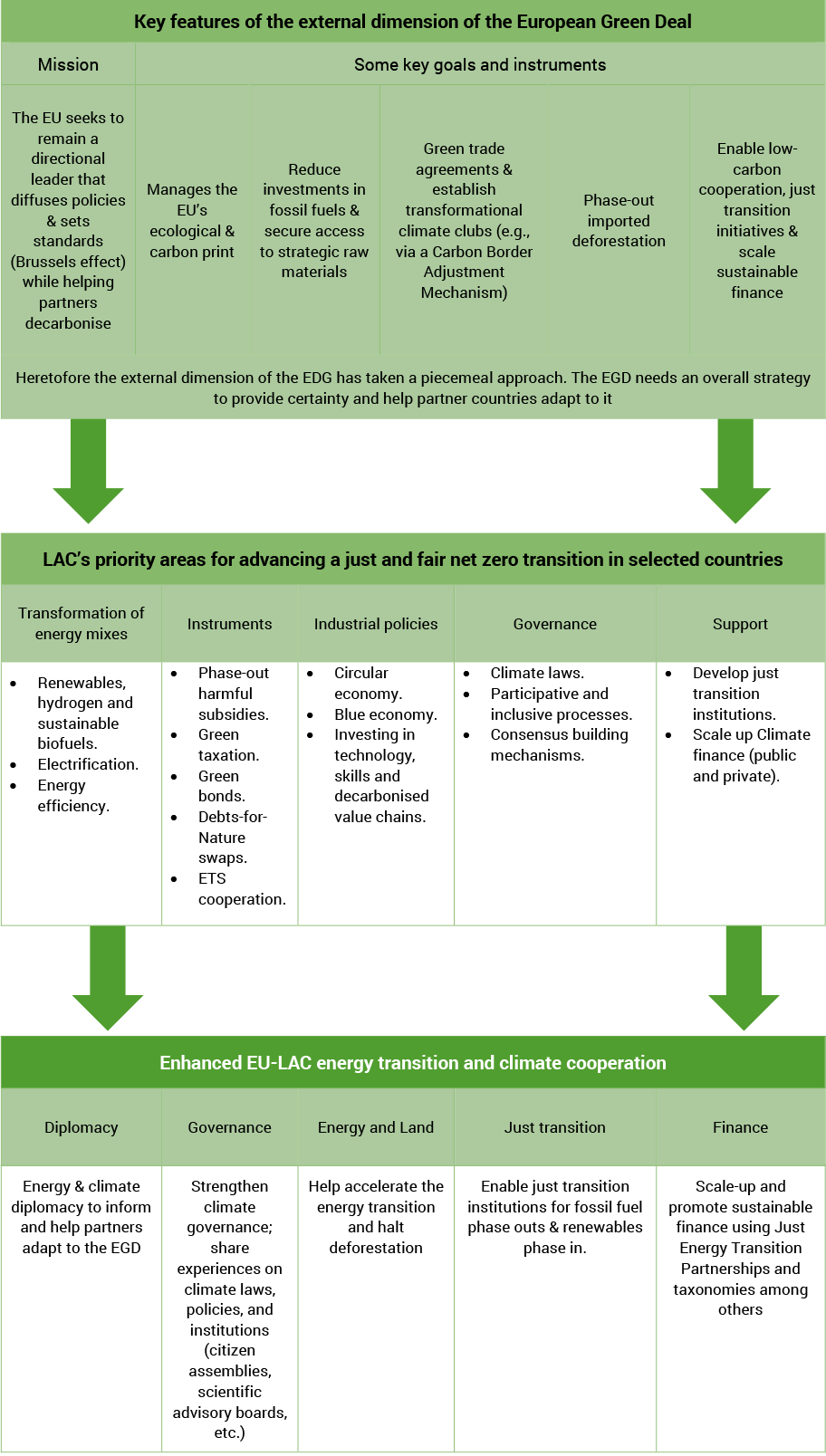Summary

Executive summary
This Policy Paper analyses the key features of the European Green Deal (EGD), its external impacts and future avenues to enhance EU-LAC cooperation in the net zero transition. The EGD seeks to deliver climate neutrality by 2050. It is a development and competitiveness strategy that strives to decouple growth from resource use, ensure a just transition and maintain an on-going dialogue with citizens to facilitate the acceptance of the increasingly stringent measures that are envisaged and result in an unprecedented change in the EU’s economy. In addition to its internal dimension, the EGD is expected to have a significant external impact on partner countries due to both the EU’s global ecological and carbon footprint and to the EU’s green norm-setting intent. The Carbon Border Adjustment Mechanism (CBAM) and the EU proposal to stop deforestation are examples of initiatives with this potential impact.
The EU and Latin America and the Caribbean (LAC) jointly contribute to under a fifth of global greenhouse gas (GHG) emissions, with some countries in LAC and the EU being considered biodiversity and climate hotspots. Countries across both regions have been instrumental in advancing climate action and strengthening ambition in the past. Although there are stark differences across countries in these two regions as regards climate impacts, ambition, energy mixes and socioeconomic contexts, strong economic and social ties, as well as a shared concern about climate change, bode well for mutual learning and cooperation across the two regions (Escribano & Urbasos, 2023).
Based on expert analyses, closed-door Track II discussions with stakeholders in the EU and LAC, a public side event co-organised by the Elcano Royal Institute and the Grantham research Institute (London School of Economics) in the Spanish Pavilion at COP27 and semi-structured elite interviews, this Policy Paper reflects on three issues. First, the heretofore limited discussion of the external dimension of the European Green Deal in selected countries in the LAC region. Secondly, some of the expected impacts of the EGD. Third, the potential for future EU-LAC collaboration. The analysis indicates that the vulnerability of LAC to climate change makes a just low carbon transition urgent, with energy and land use, land use change and forestry (LULUCF) at its heart. This is expected to require green fiscal reforms, innovative financial and regulatory tools and the strengthening of governance mechanisms, among others. This paper argues that EU-LAC cooperation could help deliver some of the elements of the net-zero transition across both regions.
The main policy recommendations to strengthen EU-LAC collaboration for climate neutrality provided in the article are:
- To focus on the diplomacy of the European Green Deal, including developing and communicating an overall external dimension and providing support for adapting to it. EGD diplomacy could also strive to nudge countries such as Brazil and Mexico to enhance their international climate commitments while fostering implementation and accountability.
- Strengthen climate governance and legislation that would, among other things, help navigate potentially conflicting policy goals and further explore the linkage of emissions trading schemes.
- Ensure just transition principles are observed in local projects developed by EU companies in the LAC region.
- Boost international (including EU) and private finance for the energy transition.
- Share the EU’s experience regarding the taxonomy for sustainable finance.
- Enhance collaboration in areas where there has so far been little so far, such as electromobility, protection of biodiversity and adaptation.
Introduction[1]
The EU and many countries in Latin America and the Caribbean (LAC) have historically played a key constructive role in the international response to climate change. Many countries in these regions are among the global leaders in terms of national ambition on climate change. Some of them were part of the High Ambition Coalition, which was pivotal for the adoption of the Paris Agreement and the inclusion of the 1.5ºC temperature increase goal in that agreement. These regions jointly contribute around a fifth of global emissions and are characterised by diverse levels of climate ambition, energy mixes, socio-economic and political contexts, vulnerability to climate change impacts and availability of financial resources to address climate change. Yet the strong socioeconomic ties, shared high concern among citizens about climate change and the value placed on international cooperation call for strengthening EU-LAC cooperation and mutual learning, as recognised by the recently presented New Agenda for Relations between the EU and Latin America and the Caribbean (EC and High Representative of the Union for Foreign Affairs and Security Policy, 2023). Current geopolitical tensions between the two largest greenhouse gas emitters (the US and China) make distributed climate cooperation and leadership a key factor in supporting climate action globally.
As Spain takes over the presidency of the Council of the EU in the second half of 2023 there is a unique opportunity to strengthen and expand the existing partnerships to enable a more effective implementation of climate policy domestically and to help fill the deficit in international climate leadership. In fact, Latin America and the green agenda are two key regional and thematic priorities of the Spanish presidency (Ministerio de Asuntos Exteriores, Unión Europea y Cooperación, 2022). Building on its strong connections and climate networks in Ibero-America, Spain is uniquely placed to advance the European Union’s diplomacy and collaboration with Latin America and the Caribbean around the Green Deal and help advance the international agenda around implementation of net zero and climate resilience objectives.
This Policy Paper discusses the potential for EU-LAC collaboration in the context of the implementation of the European Green Deal. While references are made to several LAC countries, the article focuses on Brazil, Mexico and Chile, that account for 2.2%, 1.3% and 0.23% of global emissions respectively (Cárdenas, Li Ng & Serrano, 2021; European Parliament, 2022; Palma, 2019). It is based on the discussions hosted by the Elcano Royal Institute, data collected from semi-structured elite interviews with climate experts and on exchanges at the side event at the COP 27 in November 2022 that focused on inter-regional collaboration. It also draws on the points raised in the country discussion notes prepared as input for Elcano’s working groups on Brazil, Chile and Mexico.[2] The paper starts by analysing the key features of the EU Green Deal in section 2. Section 3 turns to the green transition in the LAC region with some insights from Mexico, Brazil and Chile. Section 4 proposes a tentative agenda for EU-LAC collaboration on the European Green Deal. The conclusions summarise the discussion and offer some policy recommendations.
[1] The authors are grateful for the comments and suggestions made by Professor Carlos Malamud, Senior Analyst at Elcano Royal Institute, to an earlier version of this policy paper. The usual disclaimer applies.
[2] On Brazil by Caroline Prolo from the Latin American Climate Lawyers Initiative for Mobilising Action (LACLIMA); on Chile by Dr Luis E. Gonzales Carrasco, Economic Coordinator for Climate Change, Energy and the Environment at CLAPESUC; and on Mexico by Dr Sandra Guzmán Luna, founder of the Climate Finance Group for Latin America and the Caribbean (GFLAC).






